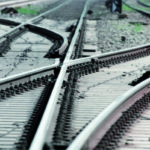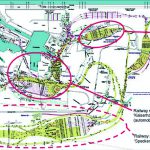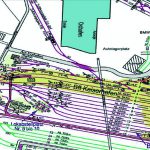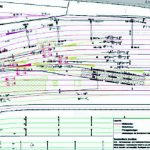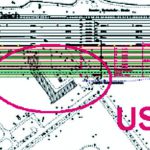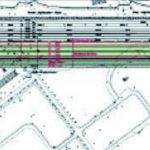Seaports today have to keep up with the requirements of growing intermodal traffic. Stefan Färber describes how an improved port railway infrastructure in Bremerhaven shall enhance transport productivity and environmental performance
An efficient infrastructure that meets the requirements of the market is and will remain crucial to the competitiveness of the[ds_preview] ports of Bremen and Bremerhaven. The same applies to the hinterland connections. Here Bremen focuses specifically on rapid and environmentally friendly freight transport by rail to relieve the road network and strengthen the sustainability of logistics.
In the medium term, seaborne throughput and handling will increase substantially in the ports of Bremen and Bremerhaven. The rail infrastructure in the immediate vicinity of the loading terminals must therefore be adjusted.
A masterplan on the port railway was worked out by the port infrastructure management company bremenports on behalf of the Senator for Economic Affairs, Labor and Ports. It describes where Bremerhaven’s railway is situated today. It also shows the need for action, and what action is urgent to increase the performance of the railway in the port.
To develop the right measures and disclose the most urgent needs of the users of the port railway system, bremenports stepped into a close dialogue with the railway companies and the logistics industry in Bremerhaven. The suggested actions in this masterplan are the future issues, bremenports is facing. The responses were recorded in the mentioned masterplan. Bremen will act to secure its future as a rail port and to support intermodality in northern Germany.
Since the publication of the masterplan, several projects have been promoted and their realisation has been decided by the different political boards and committees of the Free Hanseatic City of Bremen.
Background
The ports of Bremen and Bremerhaven are not only of extremely high importance for the regional economy and the regional labor market, but also for the performance of Germany as one of the leading exporting countries in the world. Over the last years many million Euros have been invested in new seaside infrastructure, such as the extension of the container terminal or the construction of the new sealock Kaiserschleuse. For the next years, the landside gates need to be updated, because for maintaining the competitiveness of the ports of Bremen and Bremerhaven the capacity and the quality of their hinterland connections is crucial. Especially the port railway provides a significant contribution to reducing the utilisation of the local and regional roads for more than 125 years.
By far the largest share of the handled sea cargo is attributed to the port of Bremerhaven. Mostly containers and automobiles are loaded there. The importance of rail transport for the port at the mouth of the river Weser may well be seen in the fact that its share in the hinterland container traffic in 2011 was 46 % while the cars segment even reached 80 %. Per week, an average of 558 trains reached the port of Bremerhaven in 2012. At peaks, up to 630 trains called the port. The figures of the year 2012 illustrate an increase of around 13 % compared to the year 2011, when only 493 trains were counted (443 in 2010).
To ensure the highest possible future rail share of inland traffic, the local rail infrastructure of the seaport of Bremerhaven must permanently be adjusted to the forecasted increase of water transhipment volume. With the ambition to bundle the plans already made and studies of recent years, and put together an appropriate package of realisable infrastructure and organisational measures and recommendations, the port management company was instructed by the Ministry of Economics, Labor and Ports of Bremen to draw up a masterplan for the port railway in Bremerhaven.
The creation of the masterplan was done in close cooperation with the local economy and the local operating railway companies. For this purpose, a total of about 20 companies, including companies that are busy in the field of handling and rail traffic, were involved in intensive discussions.
Afterwards, a SWOT analysis was accomplished. The strengths and the weaknesses of the port railway, as well as the opportunities and threads were considered. The result is a summary of the actual situation combined with various organisational and infrastructural recommendations for a more competitive and potent port railway in Bremerhaven.
There is no alternative to the planning and implementation of the recommendations of the masterplan. The rail tracks within the port of Bremerhaven were already highly utilised over the last years and only a small margin is left to be able to handle the expected rush of increasing future cargo volumes.
Recommendations
The main challenge for the future of the port railway in the port of Bremerhaven is to cope with the massive increase in rail freight volumes that have been traceable to the beginning of 2010. To prepare the port railway for these upcoming rising demands, the primary aim must be to increase the efficiency by operational, organisational and infrastructural measures as quickly as possible. In this context, it was recommended by the editors of the masterplan, to push the identified measures and realise the recommendations in a double-stage context, classified by their priority and feasibility.
Within a first stage, the optimisation of operational and organisational processes with the aim of operating the provided infrastructure at full capacity until the realisation of the second stage shall be achieved. After that, the second stage sets its focus on the implementation of infrastructure projects, as in detail:
• Extension of the railway tracks and full electrification of the railway station Bahnhof Kaiserhafen with the aim to optimise the handling of automobile traffic.
• Construction and modification of the pre-routing group at Imsumer Deich with the aim to increase the capacity for rail transport to and from the container terminals.
• Reorganisation and expansion of the railway station Bahnhof Speckenbüttel with the aim of creating an addition of the pre-routing function for the inlet and outlet of all port-oriented rail traffic.
In addition to rail infrastructure owners, the recommended measures have direct effects on the hinterland mode choice, for transport users and environment, and indirect effects such as changes in employment. In the future, additional container and automobile train traffic above the »normal« rail capacity in the port of Bremerhaven will most probably be transported to the hinterland via road. The capacity limit is considered to be at traffic levels experienced in 2010; the increased volumes of 2012 are handled in extraordinary circumstances.
After the recommended measures are implemented, the estimated future rail traffic growth will be handled at the rail terminals in the port of Bremerhaven properly. Otherwise, a modal backshift to road is expected to occur. The extraordinarily high positive impact of the described measures is mainly explained by the fact that these activities are meant to remedy existing rail bottlenecks of primary importance.
A. Kaiserhafen
Extension of the railway tracks and full electrification of the railway station Bahnhof Kaiserhafen with the aim to optimise the handling of automobile traffic
The railway terminal at Bahnhof Kaiserhafen is directly connected to the rail tracks of the automobile terminals in the port of Bremerhaven. Today, at Bahnhof Kaiserhafen four out of 16 tracks allow the handling of standard automobile trains operating a total length of more than 700 m (two entrances and two exit racks). In consequence, train handling requests can often either not met or trains need to be split and shunted in pieces.
There is also the fact that beyond two by-pass tracks just four out of 16 tracks (25 %) are fully electrified, which means that they can be used by incoming electrified locomotives. In contrast eight tracks are partially electrified to be used by outgoing electrified trains. Consequently a lot of automobile trains must be shunted at Imsumer Deich, which actually shall be dedicated to container trains.
These circumstances cause enormous resource inefficiencies and fairly high unproductivity of the railway network in Bremerhaven. Rail infrastructure capacity, desperately needed to handle the strongly growing automobile and container rail traffic, is blocked. To overcome these insufficiencies and productivity losses due to pre- and post-handling of waggons and trains on the port railway network and even outside the port, the railway capacity of the automobile train facilities at Bahnhof Kaiserhafen will be expanded and the overall procedures will be improved.
The measure covers the lengthening of seven tracks to 750 m and the lengthening of four other tracks to 700 m. Therefore, the southern end of the railway station will be relocated and the tracks will be lengthened accordingly. Two additional tracks will be fully electrified, so that incoming trains
can be disposed more flexible. Due to the lengthened tracks at the southern end, the existing parking spaces for shunting locomotives have to be removed. A new compound site suitable for 13 locomotives outside of the railway station has already been developed.
The measure will be managed and monitored by bremenports. Physical works will be executed by external parties based on contracts adequately tendered and controlled. All required land belongs to DB Netz AG and has already been rented by bremenports. Work and construction planning has started involving all relevant actors. A completion of the works at the Bahnhof Kaiserhafen is expected for 2016.
B. Imsumer Deich
Construction and modification of the pre-routing group at Imsumer Deich with the aim to increase the capacity for rail transport to and from the container terminals
The area of Imsumer Deich represents the only economically, environmentally and operationally feasible option in the port of Bremerhaven to install additional shunting tracks in close vicinity to the container terminals. The relatively short shunting distances will contribute to an efficient use of rail infrastructure in the port and outside the port area on the connected European rail transport network.
Therefore, the construction of an additional pre-routing group with eight railway tracks at Imsumer Deich is being suggested by the masterplan. The recommendation provides eight new tracks with an operational length of 750 m each. All new tracks will be fully electrified and equipped with state-of-the-art illumination, communication and break testing facilities.
The additional tracks will be located east of the existing ones at Imsumer Deich. The ground is right now partly used by the U.S. Armed Forces. To implement this measure on the grounds of the former Carl-Schurz-Kaserne, the relocation of a service building of the U.S. Army, which is owned by the federal government, is necessary. Due to the high level of safety requirements of the U.S. Army it is necessary to create a complete new building complex and relocate the resident U.S. Army Unit. A solution for this business was already found and the requirements of the new building were discussed with the stakeholders.
A few years ago, the container terminal operator Eurogate CTB has started to work on plans for the relocation of railway loading tracks that are currently located in the center of the container terminals CT I–III. From the operating and capacitive point of view, it would make more sense to decommission these loading tracks away from the container terminal and build new tracks and eventually a terminal related plant for intermodal containers at Imsumer Deich. Of course the existing pre-routing group at Imsumer Deich would have to be compensated at another location.
Redesigning the pre-routing group at Imsumer Deich to a terminal related plant for intermodal containers would result in far-reaching changes for the handling operation, the terminal site, and the traffic ability of a main public road.
Against this background, the plans for an extension of pre-routing group Imsumer Deich must be designed in a way that allows a possible future function shift to a terminal related plant for intermodal containers.
This measure will also be managed and monitored by bremenports. Again, the construction works will be executed by external parties based on contracts adequately tendered and controlled. At this project, all required land belongs to the Free Hanseatic City of Bremen, too. Preliminary Work and construction planning has been started in the early spring of 2013 involving all relevant actors.
C. Speckenbüttel
Reorganisation and expansion of the railway station Bahnhof Speckenbüttel with the aim of creating an addition of the pre-routing function for the inlet and outlet of all port- oriented rail traffic
The railway station Bahnhof Speckenbüttel as a railway station of DB Netz represents the link between the Germany-wide rail tracks to and from Bremen and the facilities of the port railway. It consists of different pre-routing groups and 16 directional tracks, which are divided into two groups of eight each. The station can be passed both north and south by a one-pass track.
Today, parts of the Bahnhof Speckenbüttel belong to Bremen’s port railway. The station is operated by Bremen and Deutsche Bahn. It primarily fulfils pre-routing and buffer functions for the port railway. From the perspective of Bremen, a reorganisation of the use and management of the railway station as well as an expansion of the track infrastructure is a perspective for future developments.
For any kind of action regarding Bahnhof Speckenbüttel in Bremen there is still no political decision to implement the plans. Nevertheless, bremenports already works on development plans at an advanced level to be prepared for future discussions and investments.
With regard to infrastructure measures and the aim of delivering new pre-routing tracks, the expansion of the railway station with a group of eight directional tracks would make sense.
For the port railway, Bahnhof Speckenbüttel is a very suitable place to create additional pre-routing tracks or for compensating certain possible restructurings at other locations within the port of Bremerhaven. DB Netz has already signalled willingness to lease the required open space south of the existing tracks.
The ideal solution is certainly the complete takeover of Bahnhof Speckenbüttel by the port railway. By this an overarching concept of operations could be achieved. This would also significantly simplify the implementation of future construction projects. Last but not least it should be considered in the future to implement a double railway track between Bahnhof Speckenbüttel and Imsumer Deich.
Conclusion and outlook
The above described railway infrastructure works will guarantee sufficient railway access to the port of Bremerhaven, which is a major European seaport.
The realisation of the measures will sustain competitiveness of rail towards road transport and bring good benefit in terms of transport and environmental performance. Considering the additional efficiency gains of railway infrastructure, general competitiveness of this transport mode will be increased and thereby a contribution to modal shift away from pure road transport can be expected.
By providing capacity and quality upgrades in the port and the railway hinterland, the overproportionally high share of rail at the hinterland modal split of Bremerhaven (46 % for the port’s hinterland container traffic and 80 % for the hinterland automobile traffic in 2011) – in particular compared to the other North Range seaports of Antwerp, Rotterdam and Hamburg – will be ensured, and, wherever possible, further increased.
It is generally accepted that railway transport is environmentally more friendly than road transport. Thus, the implementation of a wider rail infrastructure framework will result in substantial railway capacity and efficiency upgrades. This again will have considerable positive effects on the environment. Not least will the measures help to improve the processes on the port railway. This will lead to a higher degree of productivity of the port railway and help to keep the port of Bremerhaven at a competitive level at an environmentally friendly base.
Author:
Stefan Färber, Port Development
bremenports GmbH & Co. KG
stefan.faerber@bremenports.de
www.bremenports.de
Stefan Färber






